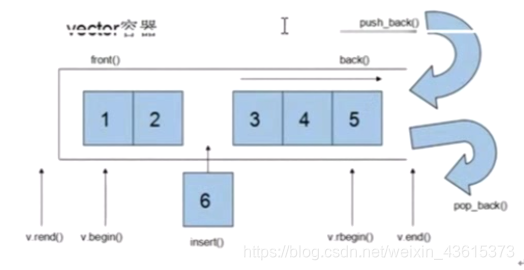1、STL概论
- 广义上分为
容器、算法、迭代器
- STL的六大组件:
- 容器:各种数据结构,如vector, list , deque, set, map 等,用来存放数据,从实现角度来看,STL容器是一中class template
- 算法:各种常用的算法,sort,find, copy, for_each, 从实现的角度来看,STL算法是一种function template
- 迭代器:扮演了容器于算法之间的胶合器,共五种类型,从实现的角度来看,迭代器是一种酱operator* , operator->, operator++ , operator–等指针相关操作予以重载的class template,所有STL容器都附有自己专属的迭代器,只有容器的设计者才知道如何遍历自己的元素。
原生指针也是一种迭代器
- 仿函数:行为类似函数,可作为函数的某种策略,从实现的角度来看,仿函数是一种重载了operator() 的class或者class template
- 适配器:一种用来修饰容器或者仿函数或者迭代器接口的东西。
- 空间配置器:负责空间的配置与管理。从实现角度看,配置器是一个实现了动态空间配置,空间管理,空间释放的class template
vector<int> v;
v.push_back(10);
v.push_back(20);
v.push_back(30);
for (vector<int>::iterator it = v.begin(); it != v.end();it++)
{
cout << *it << endl;
}
要想使用标准C++中string类,必须要包含
#include <string>
using std::string;
using std::wstring;
或
using namespace std;
string类的大部分函数:
begin 得到指向字符串开头的Iterator
end 得到指向字符串结尾的Iterator
rbegin 得到指向反向字符串开头的Iterator
rend 得到指向反向字符串结尾的Iterator
size 得到字符串的大小
length 和size函数功能相同
max_size 字符串可能的最大大小
capacity 在不重新分配内存的情况下,字符串可能的大小
empty 判断是否为空
operator[] 取第几个元素,相当于数组
c_str 取得C风格的const char* 字符串
data 取得字符串内容地址
operator= 赋值操作符
reserve 预留空间
swap 交换函数
insert 插入字符
append 追加字符
push_back 追加字符
operator+= += 操作符
erase 删除字符串
clear 清空字符容器中所有内容
resize 重新分配空间
assign 和赋值操作符一样
replace 替代
copy 字符串到空间
find 查找
rfind 反向查找
find_first_of 查找包含子串中的任何字符,返回第一个位置
find_first_not_of 查找不包含子串中的任何字符,返回第一个位置
find_last_of 查找包含子串中的任何字符,返回最后一个位置
find_last_not_of 查找不包含子串中的任何字符,返回最后一个位置
substr 得到字串
compare 比较字符串
operator+ 字符串链接
operator== 判断是否相等
operator!= 判断是否不等于
operator< 判断是否小于
operator>> 从输入流中读入字符串
operator<< 字符串写入输出流
getline 从输入流中读入一行
string类的函数原型:
string类的构造函数:
string(const char *s);
string(int n,char c);
此外,string类还支持默认构造函数和复制构造函数,如string s1;string s2="hello";都是正确的写法。当构造的string太长而无法表达时会抛出length_error异常 ;
string类的字符操作:
const char &operator[](int n)const;
const char &at(int n)const;
char &operator[](int n);
char &at(int n);
operator[]和at()均返回当前字符串中第n个字符的位置,但at函数提供范围检查,当越界时会抛出out_of_range异常,下标运算符[]不提供检查访问。
const char *data()const;
const char *c_str()const;
int copy(char *s, int n, int pos = 0) const;
string的特性描述:
int capacity()const;
int max_size()const;
int size()const;
int length()const;
bool empty()const;
void resize(int len,char c);
string类的输入输出操作:
string类重载运算符operator>>用于输入,同样重载运算符operator<<用于输出操作。
函数getline(istream &in,string &s);用于从输入流in中读取字符串到s中,以换行符'\n'分开。
string的赋值:
string &operator=(const string &s);
string &assign(const char *s);
string &assign(const char *s,int n);
string &assign(const string &s);
string &assign(int n,char c);
string &assign(const string &s,int start,int n);
string &assign(const_iterator first,const_itertor last);
string的连接:
string &operator+=(const string &s);
string &append(const char *s);
string &append(const char *s,int n);
string &append(const string &s);
string &append(const string &s,int pos,int n);
string &append(int n,char c);
string &append(const_iterator first,const_iterator last);
string的比较:
bool operator==(const string &s1,const string &s2)const;
运算符">","<",">=","<=","!="均被重载用于字符串的比较;
int compare(const string &s) const;
int compare(int pos, int n,const string &s)const;
int compare(int pos, int n,const string &s,int pos2,int n2)const;
int compare(const char *s) const;
int compare(int pos, int n,const char *s) const;
int compare(int pos, int n,const char *s, int pos2) const;
compare函数在>时返回1,<时返回-1,==时返回0
string的子串:
string substr(int pos = 0,int n = npos) const;
string的交换:
void swap(string &s2);
string类的查找函数:
int find(char c, int pos = 0) const;
int find(const char *s, int pos = 0) const;
int find(const char *s, int pos, int n) const;
int find(const string &s, int pos = 0) const;
int rfind(char c, int pos = npos) const;
int rfind(const char *s, int pos = npos) const;
int rfind(const char *s, int pos = npos, int n) const;
int rfind(const string &s,int pos = npos) const;
int find_first_of(char c, int pos = 0) const;
int find_first_of(const char *s, int pos = 0) const;
int find_first_of(const char *s, int pos, int n) const;
int find_first_of(const string &s,int pos = 0) const;
int find_first_not_of(char c, int pos = 0) const;
int find_first_not_of(const char *s, int pos = 0) const;
int find_first_not_of(const char *s, int pos,int n) const;
int find_first_not_of(const string &s,int pos = 0) const;
int find_last_of(char c, int pos = npos) const;
int find_last_of(const char *s, int pos = npos) const;
int find_last_of(const char *s, int pos, int n = npos) const;
int find_last_of(const string &s,int pos = npos) const;
int find_last_not_of(char c, int pos = npos) const;
int find_last_not_of(const char *s, int pos = npos) const;
int find_last_not_of(const char *s, int pos, int n) const;
int find_last_not_of(const string &s,int pos = npos) const;
string类的替换函数:
string &replace(int p0, int n0,const char *s);
string &replace(int p0, int n0,const char *s, int n);
string &replace(int p0, int n0,const string &s);
string &replace(int p0, int n0,const string &s, int pos, int n);
string &replace(int p0, int n0,int n, char c);
string &replace(iterator first0, iterator last0,const char *s);
string &replace(iterator first0, iterator last0,const char *s, int n);
string &replace(iterator first0, iterator last0,const string &s);
string &replace(iterator first0, iterator last0,int n, char c);
string &replace(iterator first0, iterator last0,const_iterator first, const_iterator last);
string类的插入函数:
string &insert(int p0, const char *s);
string &insert(int p0, const char *s, int n);
string &insert(int p0,const string &s);
string &insert(int p0,const string &s, int pos, int n);
string &insert(int p0, int n, char c);
iterator insert(iterator it, char c);
void insert(iterator it, const_iterator first, const_iterator last);
void insert(iterator it, int n, char c);
string类的删除函数
iterator erase(iterator first, iterator last);
iterator erase(iterator it);
string &erase(int pos = 0, int n = npos);
string类的迭代器处理:
string类提供了向前和向后遍历的迭代器iterator,迭代器提供了访问各个字符的语法,类似于指针操作,迭代器不检查范围。
用string::iterator或string::const_iterator声明迭代器变量,const_iterator不允许改变迭代的内容。常用迭代器函数有:
const_iterator begin()const;
iterator begin();
const_iterator end()const;
iterator end();
const_iterator rbegin()const;
iterator rbegin();
const_iterator rend()const;
iterator rend();
rbegin和rend用于从后向前的迭代访问,通过设置迭代器string::reverse_iterator,string::const_reverse_iterator实现
字符串流处理:
通过定义ostringstream和istringstream变量实现,#include <sstream>头文件中
例如:
string input("hello,this is a test");
istringstream is(input);
string s1,s2,s3,s4;
is>>s1>>s2>>s3>>s4;
ostringstream os;
os<<s1<<s2<<s3<<s4;
cout<<os.str();
- vector容器

- vector常用API
-
- 巧用swap()
- vector< int>(v).swap(v)

- reserve()大数据时预留空间
- at和[]越界处理的区别
- v.front()指向第一个数据和v.back()指向最后一个数据
- v.insert(v.begin(), 2, 100)参数1 迭代器 参数2 N 参数3具体插入的数据
- earse删除 clear清空容器
- 逆序遍历reverse_iterator
- const_iterator只读迭代器
- vector迭代器时随机访问的迭代器,支持跳跃访问
- deque容器
- vector容器时单向开口的连续内存空间,deque则是一种双向开口的连续线性空间

- deque常用API

-
- stack









